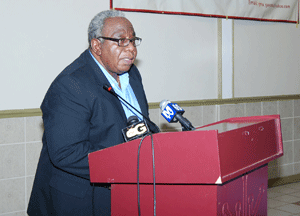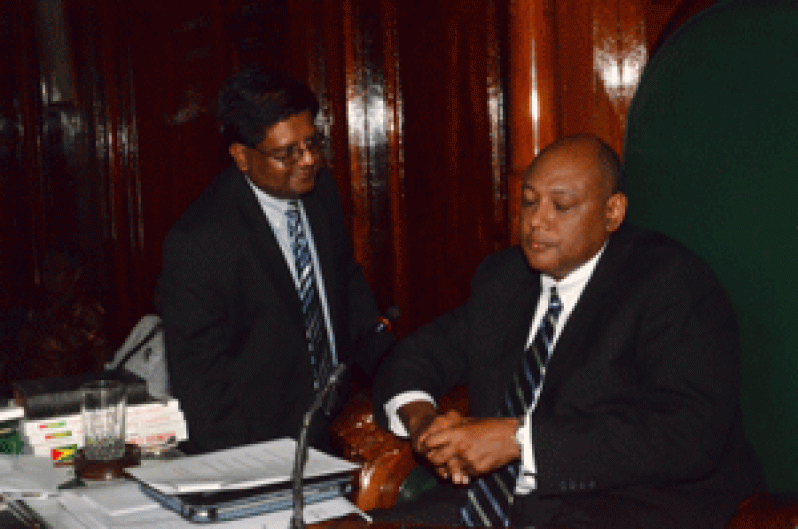DEVELOPMENT WITH A HUMAN FACE
THE human factor, the primary equation in development has been the central focus of successive PPP/C budgets since the first PPP/C budget post-1992 elections, and they were based on the various strategy initiatives programmed by Government, including its successive manifestos.  Dr. Cheddi Jagan has always pursued what was his personal mantra, development with a human face; and the party that he founded, together with its civic component, has continued this trend.
Dr. Cheddi Jagan has always pursued what was his personal mantra, development with a human face; and the party that he founded, together with its civic component, has continued this trend.
The younger generation of PPP/C leaders; and notably the current Cabinet has a crop of brilliant young ministers who would swell the heart of the Father of the Nation with pride.
Initiating the debate of the Government-side of the House during the Budget debate was Housing and Water, and Acting Trade and Tourism Minister, Irfaan Ali, who was more than a match for first presenter, Carl Greenidge of the APNU/PNC, who sanctimoniously and pompously pontificated, pronounced and prognosticated on the PPP/C administration’s management of the country’s economy; and one wonders where does this man, who presided over the destruction of this nation’s economy under the destructive PNC hurricane, get his gall.
But Minister Ali was more than a match for him, as he outlined the achievements and future projections of the Government, cutting a wide swath across all the sectors. Titling his presentation: ‘Remaining on Course, United in Purpose, with Prosperity for All’, Minister Ali said it is noteworthy that no democratically-elected Government in Latin America and the Caribbean can boast of the feat of presenting 20 successive national budgets, stating that this accomplishment is not by accident or chance, but as a result of the remarkable stewardship of the economy by the PPP/C government which in turn is responsible for it being elected to manage the affairs of the country for two decades.
Titling his presentation: ‘Remaining on Course, United in Purpose, with Prosperity for All’, Minister Ali said it is noteworthy that no democratically-elected Government in Latin America and the Caribbean can boast of the feat of presenting 20 successive national budgets, stating that this accomplishment is not by accident or chance, but as a result of the remarkable stewardship of the economy by the PPP/C government which in turn is responsible for it being elected to manage the affairs of the country for two decades.
This largest budget in the history of this land was, according to the minister, achieved at a time when governments in many parts of the world are forced to adopt austere measures, enabling Guyana to expand its investment in the economic and social sectors without introducing any new taxes, while simultaneously maintaining healthy fiscal balances.
Budget 2012, the minister argued, seeks not only to consolidate the policy gains but also advances the social and economic programmes which were initiated when the PPP/C assumed office in 1992 through programmes designed with the aim of achieving the various national priorities as set out in the various development paradigms, such as the Economic Recovery Programme (ERP), National Development Strategy (NDS), the recently launched National Competitiveness Strategy and Low Carbon Development Strategy (LCDS).
Contending that, although at the time of independence Guyana’s economy was one of the most advanced in the Caribbean, upon leaving office in 1992 the PNC’s gross mismanagement of the nation’s economic affairs had resulted in Guyana being one of the poorest countries in the Western Hemisphere.
Continuing, he said: “Probably the worst period in our post colonial history was the 1980s, when the Honourable Carl Greenidge was the Finance Minister. Indeed this period is often described by many academics as the lost decade. To better understand what occurred during the 1980s allow me to provide some important statistics.”
According to John Gaffar, in his study entitled, ‘Income Distribution, Inequality, and Poverty During Economic Reforms in Guyana’: The country recorded negative growth for 5 of the 10 years during this decade; The average GDP growth between 1981 and 1990 was negative 2.2 percent; GNP per capita declined from US$720 in 1980 to US$290 in 1989; Approximately 67 percent of the total population lived below the poverty line in 1989 compared with 55 percent in 1980; by 1988 the GDP was just 68 percent of the 1976 level and the external debt was in excess of 600 percent of GDP; The minimum wage, which was US$2.89 in 1980 fell to US$1.00 in 1989; Inflation was averaged 28.9 percent between 1980 and 1990, peaking at 66.3 percent during 1990. The lending rate moved from 12.5 percent in 1980 to 35.0 percent in 1989; the exchange rate moved from 2.50 during 1980 to 27.16 during 1989 after which it depreciated further to 39.53 and 111.8 during 1990 and 1991 respectively; the fiscal deficit as a percent of GDP averaged 39.4 percent, peaking at 66.2 percent in 1982; the external debt of the country moved from US$639 million at end-1980 to US$1,391 million at end-1989; the physical infrastructure was in total disrepair, and, (inter alia); there was a pronounced shortage of essential items.”
The minister informed the House that recent studies have shown that the only time Guyana’s economy reported above average growth rates (or accelerated) was over the 1990-1993, and over the period 2006-2011.
He noted, also, that since 2006, real GDP growth has been strong and positive in each year over the six years ending 2011, averaging 4.4%, while per capita GDP growth reached US$2,501.07 the highest average in 2010.
“Even in the midst of the most severe global economic recession since the Great Depression, the Guyanese economy, while not being completely spared from the negative effects of the crisis, was able to post real growth. In the context of deep and widespread economic contraction across Caribbean economies, Guyana’s performance may be regarded as remarkable,” Minister Ali informed the House.
Quoting from the ECLAC report of 2011, Minister Ali said that, comparatively, Guyana’s economy performed notably better than its regional counterparts. According to the minister, not only have Guyana’s rates of GDP growth improved, but so too have the macroeconomic fundamentals and key social indicators. For instance, the fiscal deficits and public debt have been on a downward trajectory since 2006. The public external debt estimated at 47.0% of GDP is one of the lowest in the Caribbean; a marked improvement relative to ratio of over 600% in 1989. Inflation has been contained in the low single digits.
Minister Ali continued his presentation by outlining some of the more defining growth poles that Government’s pro-poor budgets have facilitated, debunking all the contentions presented by Carl Greenidge.
The debate on the historic $192.8 billion began yesterday in the National Assembly and Minister Ali made a very able defence of the proposals and submissions in the 2012 National Budget, which was presented by Finance Minister, Dr. Ashni Singh two Fridays ago.
He very cleverly retorted many of Greenidge’s arguments anent corruption, transparency and accountability, with the broad framework of his arguments outlining government’s policy of creating developmental initiatives to reflect a human face, as the realization of Dr. Cheddi Jagan’s vision of development with a human face.
2012 Budget is realization of Dr. Jagan’s dream of…
SHARE THIS ARTICLE :
Facebook
Twitter
WhatsApp



.jpg)








